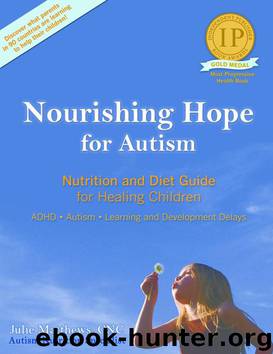Nourishing Hope for Autism: Nutrition and Diet Guide for Healing Our Children by Julie Matthews

Author:Julie Matthews [Matthews, Julie]
Language: eng
Format: epub, mobi
Tags: Health
Published: 2012-10-14T04:00:00+00:00
Specific Carbohydrate Diet (SCD)
The Specific Carbohydrate Diet introduced by Dr. Merrill Haas and made popular by Elaine Gottschall in Breaking the Vicious Cycle: Intestinal Health Through Diet eliminates all disaccharides (two-sugar molecules) and polysaccharides (starches). Only monosaccharides (glucose, fructose and galactose) such as fruits, honey, and most non-starchy vegetables are allowed. In a nutshell (so to speak), this means all sugars (except monosaccharides) and starches are out, including but not limited to table sugar, maple syrup, rice, pastas, breads, potatoes, certain beans, rice milk, and cornstarch.
The diet uses the principle that some individuals cannot digest carbohydrates, most likely due to damage to the small intestine mucosa. This maldigestion leads to malabsorption of disaccharides, which cause bacteria and yeast overgrowth as they feed on the unabsorbed complex sugars. These bacteria destroy enzymes further inhibiting carbohydrate metabolism and creating further damage to the small intestine villi and microvilli completing a “vicious cycle” that continues to deteriorate.
Since monosaccharides are already single sugar molecules nothing needs to be broken down. By absorbing immediately into the small intestine, these sugars can be eaten with no problem and appear to not feed the harmful microorganisms.
Some comments on dairy and raw dairy
Please note that SCD allows for dairy that is lactose free, including certain cheeses and homemade yogurt. Those individuals with casein sensitivity should not include dairy products. However, some researchers and clinicians such as Dr. Mercola (www.mercola.com) believe that the problems with dairy stem from pasteurization, as this process kills the natural enzymes and good bacteria found naturally in milk. It is hypothesized that pasteurization (and maybe homogenization) changes the molecular structure of the protein molecules possibly causing casein intolerance. Additionally, commercial milk is from cows fed grain rather than grass-fed, which could be creating the inflammation found in those who are sensitive to dairy. Some clients of mine, once they spent time healing the gut, were able to consume raw dairy. In one study, Lactobacillus rhamnosus GG reduced casein sensitivity in infants (Isolaruri, 2001). Perhaps, as the gut heals and good bacteria are restored, dairy can be consumed without inflammatory reaction. Raw dairy contains good bacteria, enzymes, and butyric acid which helps support a healthy intestinal tract. Some states ban the sale of raw dairy and people wishing to obtain it must participate in a cow share program. Other people buy raw milk as “pet food” from their state or another state (Organic Pastures from California does so). Based on my personal experience of using raw yogurt, my clients’ experience with raw dairy, and the research I have done I feel comfortable with raw dairy. However, many scary things have been said about raw dairy, especially for those who are immune-compromised, so in order to be comfortable with your decision and other people’s responses do your own research before proceeding on this personal decision.
See Appendix VIII for more details on raw dairy. There is more information on my website (NourishingHope.com), and well as on RealMilk.com.
When to use this diet: SCD was originally used for those
Download
Nourishing Hope for Autism: Nutrition and Diet Guide for Healing Our Children by Julie Matthews.mobi
This site does not store any files on its server. We only index and link to content provided by other sites. Please contact the content providers to delete copyright contents if any and email us, we'll remove relevant links or contents immediately.
Nutrition for Sport, Exercise, and Health by Spano Marie & Kruskall Laura & Thomas D. Travis(3559)
Nutrition for Sport, Exercise, and Health by Marie Spano & Laura Kruskall & D. Travis Thomas(3553)
The Sprouting Book by Ann Wigmore(3414)
Flavor Flours by Alice Medrich(2648)
Memory Rescue by Daniel G. Amen(2260)
Superfood Smoothie Bowls: Delicious, Satisfying, Protein-Packed Blends that Boost Energy and Burn Fat by Chace Daniella(2238)
Dirty Genes by Ben Lynch(2163)
The Bad Food Bible by Aaron Carroll(2125)
The Poisoner's Handbook by Deborah Blum(1981)
Genius Foods by Max Lugavere(1977)
Good Calories, Bad Calories by Gary Taubes(1954)
The Main Street Vegan Academy Cookbook by Victoria Moran(1942)
The I Quit Sugar Cookbook by Sarah Wilson(1880)
Core Performance Essentials by Mark Verstegen(1862)
Memory Rescue: Supercharge Your Brain, Reverse Memory Loss, and Remember What Matters Most by Amen Dr. Daniel G(1850)
Big Girls Do It Stronger by Jasinda Wilder(1805)
Android App Development by Franceschi Hervé J.;(1735)
Sugar Crush by Dr. Richard Jacoby(1689)
Dr. Colbert's Keto Zone Diet by Don Colbert(1549)
